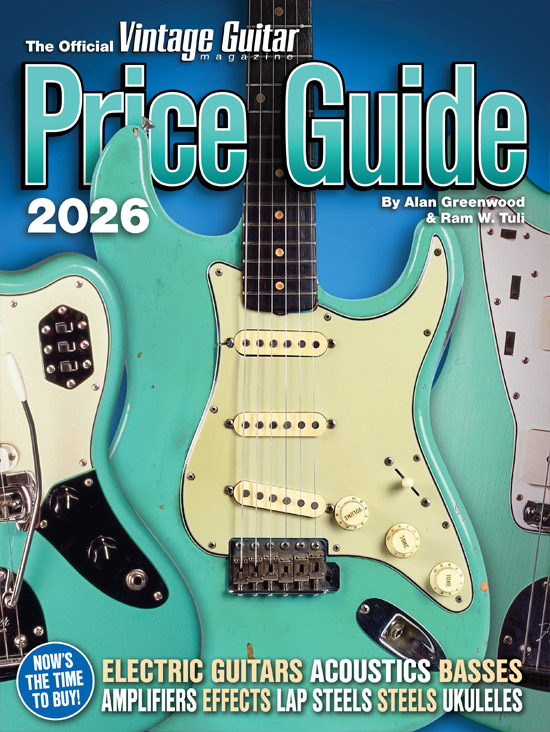
If a Venn diagram reveals a surprising truth between overlapping concepts, Richie Kotzen is the Venn core of heavy rock, fusion, and soul-funk guitar. This multiple-threat instrumentalist plays almost all the instruments on Nomad, including drums, delivering a tour-de-force of rockin’ funky jams. With strong writing, the album also showcases Kotzen’s powerhouse voice and guitar work that ranges from sweet jazz to face-melting shred. Let’s catch up with the Venn master and analyze his uncanny platter.
Funk, heavy rock guitar, and jazz-fusion aren’t supposed to exist in the same song, but you do that naturally on “Insomnia.”
I grew up listening to a lot of R&B, from Parliament/Funkadelic to Stevie Wonder. Stevie was my first concert, then I saw George Benson, so that’s the root of my influence. After that, I got into heavier rock, and Kiss would be the first rock band that caught my attention, immediately followed by Iron Maiden. So, by the nature of what I was exposed to, my influences are in that wheelhouse.
The opener, “Cheap Shots,” is reminiscent of a smokin’ Kiss rocker.
Again, Kiss was a big reason why I got into rock and roll. My father made a Gene Simmons suit that I would parade around in through the house, so it’s surreal as an adult musician to have met the band and be on friendly terms with those guys. It’s very cool and something that I’m very happy about – I’ve always loved Kiss.
Your solo on “These Doors” starts with jazz over R&B lines – and then freaks out.
I like the way you describe that it “freaks out” because it does go berserk (laughs). I have a Leslie rotating-speaker simulator made by Tech 21 that lives in my RK5 FlyRig; anyone who purchases that Fly Rig can get that exact sound. It’s the rotating speaker at full speed, and it gives you that wacky modulation effect.
Do you come up with any preconceived ideas for guitar solos?
I push “Record” and let it rip. My attitude is, “Let’s see what happens,” because that’s the best of both worlds. You’ve got true inspiration happening in the moment, then if you decide to amend a solo you played as part of an improvisation, you compose a new guitar part.
Which pedals and amps did you use on Nomad – or did you record with software?
I would not be caught dead using software on guitar – I don’t like the way it sounds. The amplifier on most of the recording is a Marshall Handwired 1959 100-watt head. If it’s not that, it’s a Fender Vibro-King. Sometimes, I plugged direct into an API mic preamp with an Anthony DeMaria Labs compressor for clean sounds. As far as pedals, mostly that RotoVibe-type setting in the Tech 21 Fly Rig.
What about guitars?
Most of what you’re hearing is my signature Telecaster and signature Stratocaster. Occasionally, I use a Yamaha hollowbody that looks very much like a Gretsch; I’ve had that guitar for a very long time and you can hear it on the rhythm to “Cheap Shots.”
“Nihilist” is a cool piece of vocal and guitar fusion that works great to close the album.
The funny thing is that “Nihilist” is the first song I wrote, and for me it’s the most important song on the record. It’s a true representation of me as a solo artist because it covers so much ground in one composition.
You’ve been recording and touring for 35 years, almost nonstop. Are you a musical workaholic?
I do love the creative process. When I have an idea and it comes out in the form of the finished song, that’s absolutely my favorite part of all this. I’m aware that the impression on the outside is that I’m always working, the truth is I’m not; in fact, I was recently talking to someone about the extraordinary amount of time that passes when I don’t touch a musical instrument. After the Winery Dogs tour ended in 2023, I didn’t play for three months. Then I went on the Monsters of Rock cruise and did a show; it was exciting because I was on one hand worried about whether I was going to be able to play, but on the other hand, everything felt new again. Even though I’m not always active, I think that’s what propels me moving forward. This way, I can put out a record and still get excited about new music.
This article originally appeared in VG’s December 2024 issue. All copyrights are by the author and Vintage Guitar magazine. Unauthorized replication or use is strictly prohibited.



